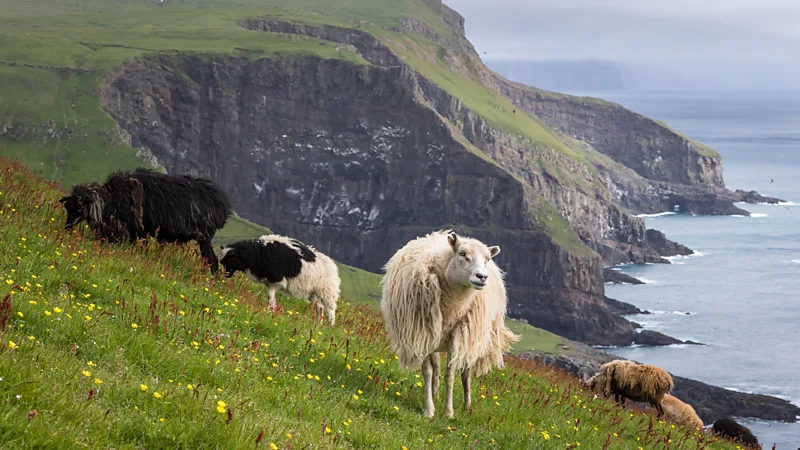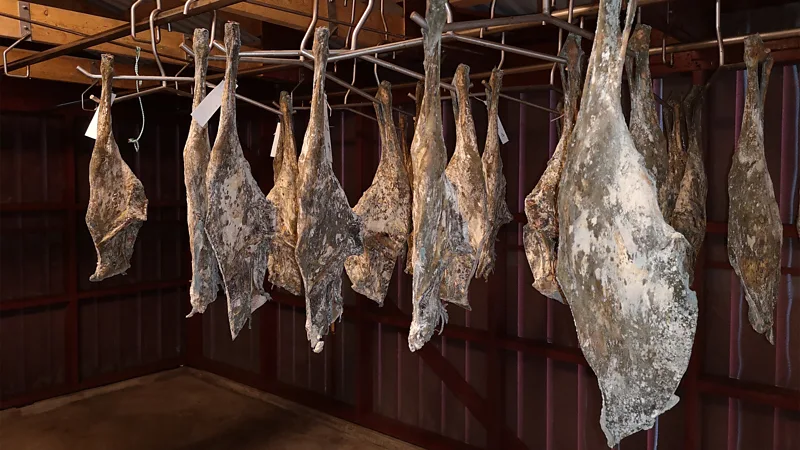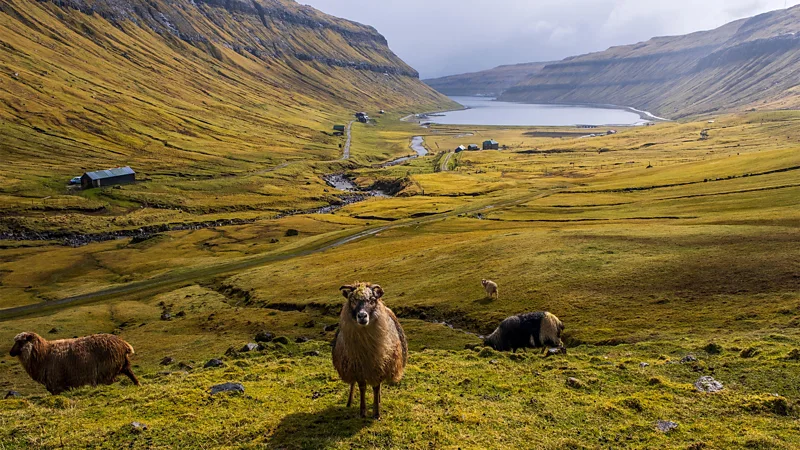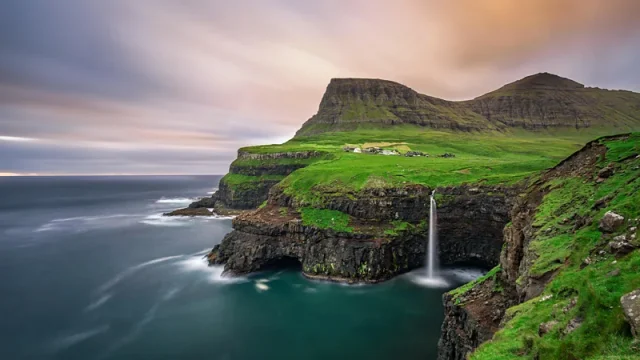Introduction: The Sheep Islands and Their Significance
The Faroe Islands, meaning “Sheep Islands,” derive much of their distinct identity from the resilient, tangle-haired sheep that have inhabited these rugged landscapes for over a millennium. These animals are more than just livestock; they are integral to the cultural and natural history of this remote North Atlantic archipelago. The influence of these sheep is evident in everything from the landscape and local cuisine to Faroese traditions and even the name of the islands themselves.
The Seyðabrævið: The Oldest Surviving Faroese Document
While visiting the Faroe Islands National Archives in Tórshavn, the capital, I discovered a small yet significant artifact that underscores the importance of sheep in Faroese history. The artifact, known as Seyðabrævið or “the Sheep Letter,” is a collection of laws dating back to 1298. This ancient document, enacted by then-Norwegian ruler Earl Hákon Magnússon, is the oldest surviving Faroese manuscript. The laws within the Seyðabrævið detail various aspects of sheep farming, including compensation for allowing a dog to chase another man’s sheep, disputes over grazing lands, and the management of wild sheep. This legal codification highlights the central role that sheep have played in the Faroese way of life for centuries.
A Year Among the Sheep: Living in the Faroe Islands
During my year-long stay in these sparsely populated islands, I often found myself surrounded by the dark green mountains and the omnipresent sheep. The presence of these hardy animals, grazing the slopes and shaping the landscape, made me feel connected to the land in a way that is unique to the Faroes. The sheep have been instrumental in maintaining the islands’ ecology, keeping the vegetation primarily grass-covered and contributing to the dramatic and windswept scenery that defines this remote region.

The Geography and History of the Faroe Islands
A Volcanic Archipelago in the North Atlantic
Located between Scotland and Iceland, the Faroe Islands consist of 18 volcanic islands that are part of the Kingdom of Denmark. Despite their isolation, these islands are a vibrant mix of traditional Scandinavian culture and stunning natural beauty. The islands are characterized by their sharp cliffs, thundering waterfalls, and deep fjords, attracting a growing number of tourists each year.
Early Inhabitants: From Irish Monks to Viking Settlers
The islands were first inhabited by Irish monks in the 6th Century CE, followed by Viking settlers in the 9th Century. Today, the Faroese population of around 54,000 people speaks Faroese, a language closely related to Old Norse. The name of the islands in Faroese, Føroyar, translates to “Sheep Islands,” underscoring the enduring significance of sheep in Faroese culture.
The Cultural and Economic Importance of Faroese Sheep
Sheep as a Cultural Symbol
Sheep have been central to the Faroese economy and culture since the islands were first settled. These semi-wild sheep have provided meat and wool, essential for survival in this harsh environment. The rearing of sheep remains a communal activity, with most Faroese families owning a share in a flock. The autumn roundup, where families gather to slaughter sheep and divide the meat, is a tradition that continues to this day.

Faroese Cuisine: The Role of Fermented Lamb
In the Faroes, sheep are more than just livestock; they are a dietary staple. The islands’ challenging climate, with strong winds and frequent rain, makes it difficult to grow crops. As a result, Faroese cuisine has evolved to include fermented lamb and mutton, known as skerpikjøt. This pungent food is shaped by the unique Faroese climate, where meat is hung in sheds called hjallur to dry and ferment. Over time, the meat develops a strong, cheesy flavor, passing through stages of moisture and drying before reaching its final, fermented form.
Wool: Faroes’ Gold
The importance of sheep extends beyond meat to wool, which has long been considered “Faroes’ gold.” Traditional Faroese knitwear, made from the thick, hairy yarn of Faroese sheep, is still highly valued. Knitting clubs are common in Faroese villages, and the distinctive hand-knitted jumpers are worn year-round. This tradition highlights the significance of sheep in both the cultural and economic life of the islands.
Sheep as a National Symbol
Faroese Sheep in Tourism and National Identity
In a country named after them, it’s only natural that sheep have become a national symbol. The Faroese tourism board‘s logo features a ram’s head, and one of the country’s most popular beer brands is named Black Sheep. In Tórshavn, a bronze statue of a ram stands as a tribute to these animals, and it is a popular spot for children who love to climb on its back. Created by Faroese sculptor Rógvi Hansen, this statue is just one of several sheep monuments in the capital, reflecting the deep connection between the Faroese people and their sheep.
The Success of “Sheep View”
In 2016, the Faroese government launched a creative tourism campaign called “Sheep View,” a parody of Google Street View. This campaign featured camera-carrying sheep exploring the islands, and it quickly captured the world’s attention. The campaign was a success, significantly raising the islands’ profile as a tourist destination. According to Guðrið Højgaard, CEO of Visit Faroe Islands, the campaign was a way to celebrate the importance of sheep in Faroese culture and to share this unique aspect of the islands with a global audience.
Exploring Faroese Sheep Culture
Sheep-Related Tourism
The fascination with Faroese sheep has led to an increase in sheep-related tourism. Visitors from countries with a strong sheep culture, like New Zealand and Australia, often request tours that include meeting Faroese shepherds or participating in the autumn roundup. According to Høgni Reistrup, who runs the local tour agency Guide to the Faroe Islands, these experiences are highly sought after, particularly during the photogenic autumn season.

Culinary Experiences and Traditional Dining
Tourists can also experience Faroese sheep culture through food. Restaurants in Tórshavn, such as Ræst, offer dishes made with the islands’ famous fermented lamb. Additionally, some farmers participate in heimablidni, a home-dining scheme that allows visitors to enjoy traditional meals in a Faroese home. One such experience is offered by sheep farmer Jákup Petersen, who leads guided hikes on his land near Kaldbak, where visitors can sample wind-dried skerpikjøt made from his own sheep.
The Legacy of Faroese Sheep
The Endurance of Faroese Sheep
The resilience of Faroese sheep is a testament to their adaptability to the islands’ harsh conditions. Eva ur Dímun, the eighth generation of her family to farm sheep on the small island of Stóra Dímun, speaks with admiration for these animals. Despite the challenges of farming in such a remote and rugged environment, Faroese sheep have thrived for centuries, surviving on a diet of grass and enduring the islands’ relentless winds, rain, and snow.
The Evolution of Faroese Sheep Breeds
Visitors to the Tórshavn National Museum can learn about the evolution of Faroese sheep. A glass display case contains the taxidermied remains of three brown sheep, much smaller and less woolly than today’s Faroese sheep. These are the last-known examples of the original Faroese breed that the Vikings encountered when they arrived in the 9th Century. In the 19th Century, larger and heavier sheep from Scotland, Iceland, and Norway replaced the native breed, providing more meat and better-quality wool.
Conclusion: The Faroe Islands and Their Sheep
From the time of the Viking settlers to the present day, the Faroe Islands have been shaped by their sheep. These animals have sculpted the land, sustained the population, and become an enduring symbol of Faroese culture and identity. As the islands continue to attract tourists from around the world, the sheep remain a central part of the Faroese story, embodying the resilience and spirit of this unique North Atlantic nation.











